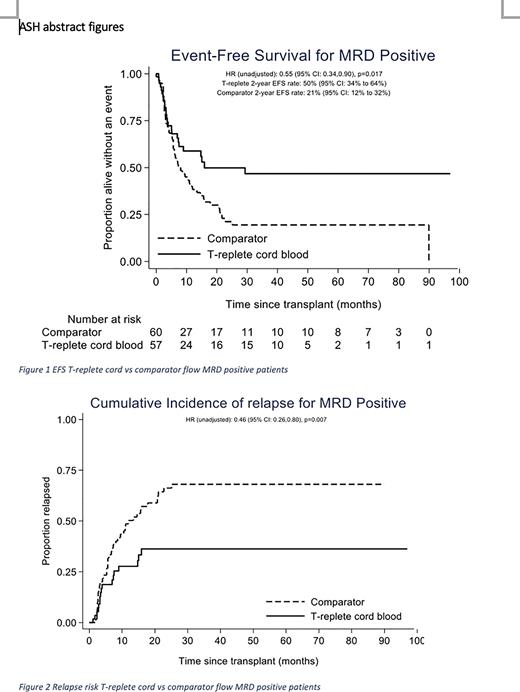Abstract
Introduction: Outcomes of alternate donor haematopoietic stem cell transplant (SCT) in high-risk (HR) and relapsed or refractory (R/R) paediatric acute myeloid leukaemia (AML) and myelodysplastic syndrome (MDS) have been poor historically. Cord blood (CB) allows T-cell replete transplant, potentially enabling enhanced graft-versus-leukaemia (GVL) in patients with myeloid malignancies. We report the utility of T-replete CB (TRCB) transplant in high-risk paediatric myeloid malignancies in a large multi-centre national analysis, compared with patients transplanted with similar disease and at the same time using other donor sources.
Methods: Data was collected from consecutive patients undergoing TRCB transplant for paediatric AML or MDS in 10 UK and Republic of Ireland paediatric bone marrow transplant centres between January 2014 and December 2021. The comparator group consisted of consecutive paediatric patients undergoing either a T-cell depleted (i.e. plus serotherapy) CB SCT or a transplant using any other cell source (matched sibling, matched/mismatched unrelated donor, or haplo-identical donor) at the same centres over the same period for the same indication. Information was gathered directly from the centre using an agreed data proforma and cross-checked for accuracy and completeness against the BSBMT/EBMT data submissions of each centre.
Results: Data for 367 patients was analysed in this retrospective analysis which included 112 TRCB recipients and 255 patients in the comparator group. Median follow up was 2 years in the TRCB cohort and 4.5 years in the comparator group. All rates are quoted at 2 years. The median ages were 6.5 years in the TRCB group and 8.9 in the comparator, 91% of each group were AML.
The TRCB cohort appeared to be a worse prognosis group with 51.4% of patients flow MRD positive at transplant compared with 26.1% in the comparator group (p <0.001), 46.4% had physician-defined refractory disease at transplant and 21.4% had relapsed following a previous SCT, compared with 8.6% refractory and 5.1% previous SCT in the comparator group (p<0.001 and p<0.001).
Within the TRCB cohort Overall survival (OS) and Event Free Survival (EFS) were 64.7% and 64.1%, with EFS of 50% in those that were flow MRD positive at SCT and 79% for flow MRD negative patients (p= 0.009). EFS stratified by clinical disease status was 60.9% for those with primary refractory disease (n=29), 46.5% in those with relapsed refractory disease (n=23), 67% for those in high risk CR1 (n=38) and 79.6% for those in CR2 (n=22). For the 24 patients who had received a previous BMT, EFS was 69%. 67% TRCB recipients developed acute GVHD, of which 30% was grade 3-4, but the rates of chronic GVHD were very low at 5%.
To allow for the imbalance in baseline characteristics, a multivariate analysis (MVA) was performed: the TRCB cohort had significantly improved EFS (0.57(0.35-0.91), p=0.019) and time to relapse (0.46(0.26-0.81), p=0.008) with some evidence of improved OS (0.65(0.39-1.07), p = 0.088). The effect appeared similar for MRD positives and negatives (interaction p=0.29 EFS and 0.67 relapse). Figures 1 and 2 highlight the strikingly superior EFS and relapse risk in the TRCB cohort for MRD positive patients in univariate analysis.
Transplant-related mortality (TRM) was higher in the TRCB setting, 12% vs 7% (2.05 (1.05, 4.01), p=0.036) but rates of chronic GVHD were significantly lower with TRCB compared to other SCT types, 4.9% vs 19.4% (0.25(0.10, 0.62), p=0.003).
Conclusion: This is the largest reported analysis of TRCB outcomes in HR paediatric myeloid malignancy, and we demonstrate excellent results, even in refractory disease. Our data show significantly superior outcomes for patients receiving TRCB compared with other transplant cell sources, owing to a lower relapse risk in the CB setting. This is likely to reflect enhanced GVL effects with TRCB compared with alternate donor sources requiring T-cell depletion. Despite higher TRM in the TRCB setting, when adjusted for the confounding variable of more MRD positive patients in this group, EFS and relapse are highly significant with a strong trend for improved OS. Our data suggests that CB transplant without serotherapy may be the optimal transplant option for children with HR and R/R AML/MDS, particularly with strategies to mitigate the higher TRM. This potential practice change warrants exploration in a large prospective randomised controlled trial.
Disclosures
Kirkwood:Kite: Consultancy, Honoraria. Amrolia:Bluebird Bio: Research Funding; Pierre Fabre: Consultancy; UCL Business: Patents & Royalties; Bluebird Bio: Research Funding; Pierre Fabre: Consultancy; Autolus: Patents & Royalties, Research Funding; ADC Therapeutics: Patents & Royalties: named inventor WO2022063853A1.
Author notes
Asterisk with author names denotes non-ASH members.


This feature is available to Subscribers Only
Sign In or Create an Account Close Modal